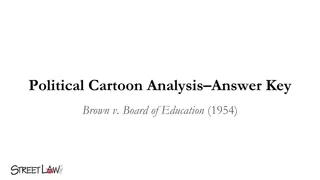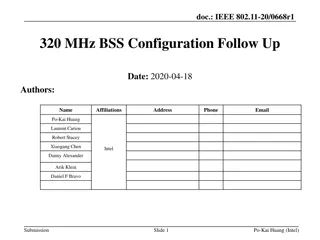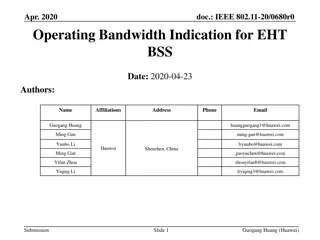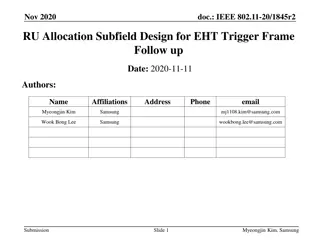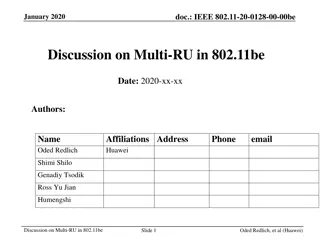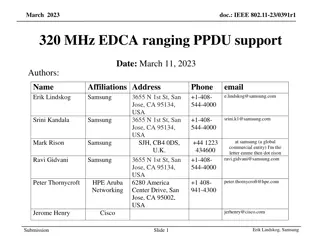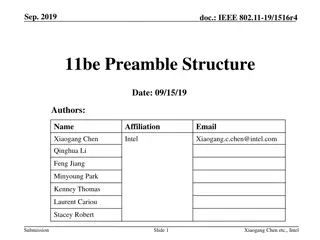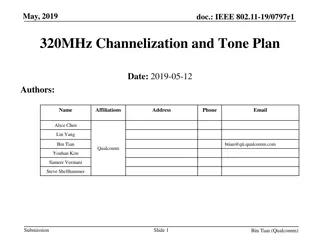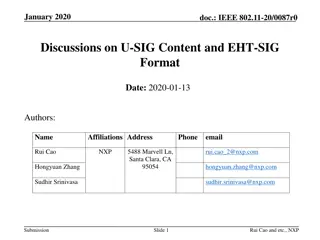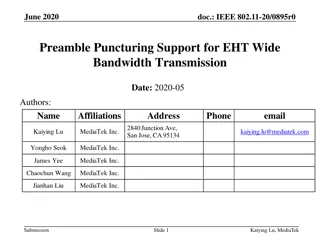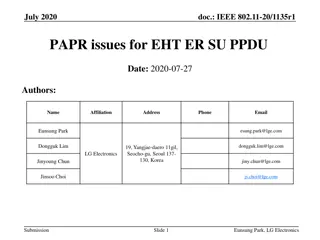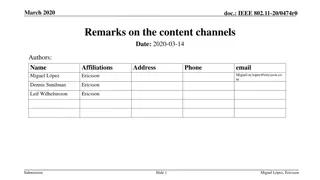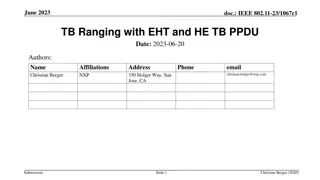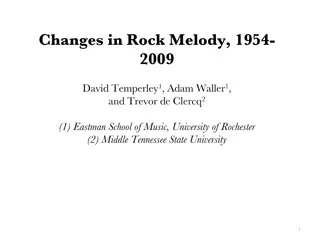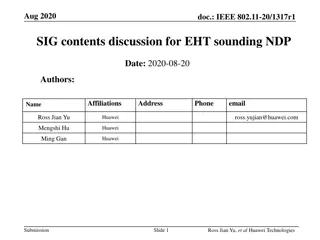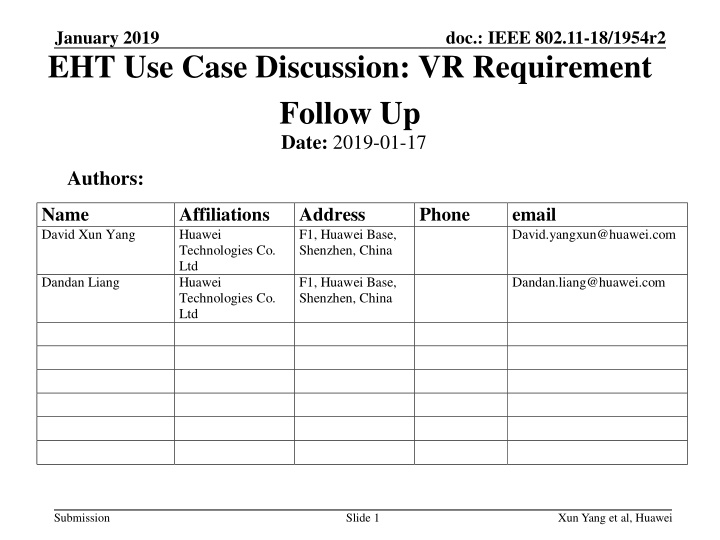
Virtual Reality Use Case Analysis: VR Requirements in IEEE 802.11-18/1954r2
Explore the detailed analysis of Virtual Reality requirements focusing on throughput, latency, and interference in the IEEE 802.11-18/1954r2 standard. Discover the impact of latency on VR experiences, along with key considerations for optimizing image quality and immersive VR interactions.
Download Presentation

Please find below an Image/Link to download the presentation.
The content on the website is provided AS IS for your information and personal use only. It may not be sold, licensed, or shared on other websites without obtaining consent from the author. If you encounter any issues during the download, it is possible that the publisher has removed the file from their server.
You are allowed to download the files provided on this website for personal or commercial use, subject to the condition that they are used lawfully. All files are the property of their respective owners.
The content on the website is provided AS IS for your information and personal use only. It may not be sold, licensed, or shared on other websites without obtaining consent from the author.
E N D
Presentation Transcript
January 2019 EHT Use Case Discussion: VR Requirement Follow Up Date: 2019-01-17 doc.: IEEE 802.11-18/1954r2 Authors: Name David Xun Yang Affiliations Huawei Technologies Co. Ltd Huawei Technologies Co. Ltd Address F1, Huawei Base, Shenzhen, China Phone email David.yangxun@huawei.com Dandan Liang F1, Huawei Base, Shenzhen, China Dandan.liang@huawei.com Submission Slide 1 Xun Yang et al, Huawei
January 2019 doc.: IEEE 802.11-18/1954r2 Summary Reference [1] has introduced the use case of VR, including the scenario and requirement of throughput and latency This presentation further analyzes the effect of latency and interference Submission Xun Yang (David), Huawei
January 2019 doc.: IEEE 802.11-18/1954r2 Background: VR Use Cases [1] VR Movie, VR Gaming, Virtual Social, VR Live Broadcasting AP plays a key role in VR system Bad Experience: Insufficient image clarity Image smearing Black border Dizziness Cloud VR Head display is very heavy because of lots of image processing Home VR Portable VR Submission Slide 3 David Xun Yang, Huawei, et al
January 2019 doc.: IEEE 802.11-18/1954r2 Background: VR Requirement The requirement of VR is calculated in the following table [1] Monocular Video Resolution Lightly Compressed Rate (Gbps) Horizont al FOV Vertical FOV Bits per Pixel Fram e Rate Yuv444/ yuv420 Raw Rate (Gbps) Compressed Rate (Gbps) RTT Latency PPD 2D, 40.83/ 20.42 2D, 4.08/ 2.04 2D, 0.20/ 0.10 Partial Immersion 30 210 100 6300*3000 12 60 3/1.5 10ms 3D, 81.66/ 40.84 3D, 9.66/4.04 3D, 0.48/0.20 2D, 2D, 23.6/ 11.8 2D, 1.18/0.59 236.20/118.10 Deep 45 360 100 16200*4500 12 90 3/1.5 5ms Immersion 3D, 3D, 47.2/23.6 3D, 2.36/1.18 472.40/236.20 2D, 2D, 80.62/ 40.31 2D, 4.03/2.02 806.22/403.11 Ultimate Immersion 60 360 120 21600*7200 12 144 3/1.5 5ms 3D, 3D, 3D, 8.06/4.03 1612.44/806.22 161.24/80.62 * Assuming the compression ratio is 1/200 (H.265) Typical requirement of VR for Wireless Transmission Raw stream or lightly compressed stream is preferred PHY Link Throughput > 30Gbps The total latency should be 20ms [2], total latency(video) = T_trans(Data) + T(Decompression) + T(Rendering) + T(Display); total latency(game) = T_trans(Data) + T_trans(Control) + T(Compression) + T(Decompression) + T(Rendering) + T(Display) Submission Slide 4 Xun Yang (David), Huawei
January 2019 doc.: IEEE 802.11-18/1954r2 Case1: Latency from Compression/Decompression Image/Video compression and decompression are good for reducing required data rate, but they increase the system latency at the same time Usually either compression or decompression takes several tens of ms 10ms for each is an extremely small number VR Video VR Game T(Compression)=10ms T_trans(Data) T_trans(Control) T_trans(Data) T(Decompression)=10ms T(Rendering) ~= 3ms T(Display) ~= 5ms T(Decompression)=10ms T(Rendering) ~= 3ms T(Display) ~= 5ms Submission Xun Yang (David), Huawei
January 2019 doc.: IEEE 802.11-18/1954r2 Analysis of Data Rate and Latency from Compression and/or Decompression total latency(video) T_trans(Data) + T(Decompression) + T(Rendering) + T(Display) = T_trans(Data) + 10 + 3 + 5 20ms T_trans(Data) 2ms The transmission latency for data could be met for video total latency(game) T_trans(Data) + T_trans(Control) + T(Compression) + T(Decompression) + T(Rendering) + T(Display) = T_trans(Data) + T_trans(Control) +28 It is impossible to meet the latency requirement of VR (20ms) if we apply full compression at the server. Only uncompressed video or lightly compressed video can meet the requirement of latency of game. Lightly Compressed Rate (Gbps) Yuv444/ yuv420 Raw Rate (Gbps) Compressed Rate (Gbps) 2D, 40.83/20.42 2D, 4.08/ 2.04 2D, 0.20/ 0.10 Partial Immersion 3/1.5 3D, 81.66/ 40.84 3D, 9.66/4.04 3D, 0.48/0.20 2D, 236.20/118.10 2D, 23.6/ 11.8 2D, 1.18/0.59 Deep Immersion 3/1.5 3D, 472.40/236.20 3D, 47.2/23.6 3D, 2.36/1.18 2D, 806.22/403.11 2D, 80.62/ 40.31 2D, 4.03/2.02 Ultimate Immersion 3/1.5 3D, 1612.44/806.22 3D, 161.24/80.62 3D, 8.06/4.03 Submission Xun Yang (David), Huawei
January 2019 doc.: IEEE 802.11-18/1954r2 Case2: Latency from Contentions and Collisions We have done a VR test for video transmission in the real environment Scenario: One VR transmission only with four surrounding neighbors 11ac AP, 5GHz, BW: 20MHz, single stream, transmission rate: 40Mbps Neighbor 3 (Upstairs) User Scenarios Experience Neighbor 1 Neighbor 2 Two parallel transmissions in adjacent channels Packet Loss: a few Latency: a few longer than 20ms around -40dB around -70dB One co-channel transmission and two parallel transmissions in adjacent channels Packet Loss: frequent Latency: almost all longer than 20ms Continuously frozen Neighbor 4 (Downstairs) Submission Xun Yang (David), Huawei
January 2019 doc.: IEEE 802.11-18/1954r2 Analysis from the Test Co-channel contentions/collisions result in a much longer latency, which affects the user experience of AR/VR a lot Submission Xun Yang (David), Huawei
January 2019 doc.: IEEE 802.11-18/1954r2 Conclusion WLAN should support sufficient throughput and try to limit the latency in an acceptable number Raw video or lightly compressed video has to be used in VR game WLAN has to ensure the throughput requirement from the transmission of raw video or lightly compressed video as shown in page 6 Interference is another key factor that has to be considered Submission Xun Yang (David), Huawei
January 2019 doc.: IEEE 802.11-18/1954r2 Reference [1] 11-18-0846-02-0wng-802-11-for-sub-7ghz-next-generation-phy-mac [2] 21-1-0073-00-0000-hmd-based-vr-applications-issues-and-challenges Submission Slide 10 Xun Yang (David), Huawei

